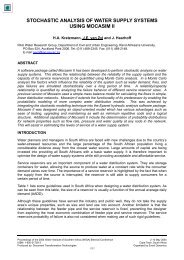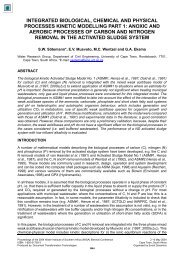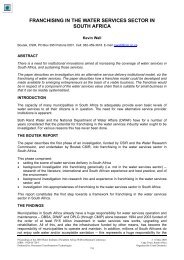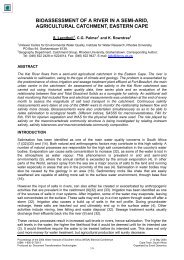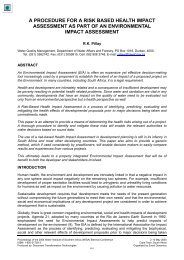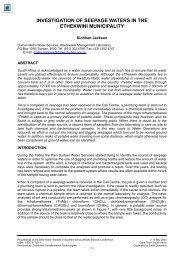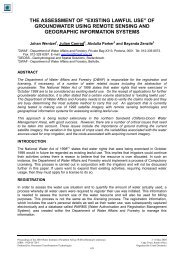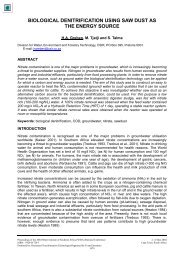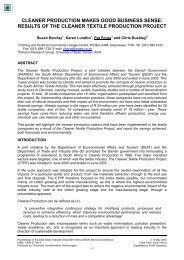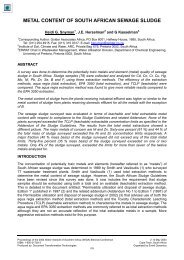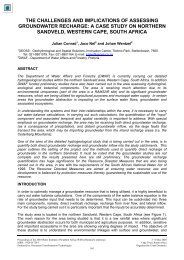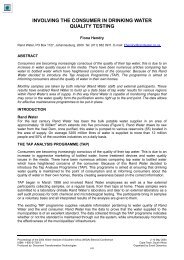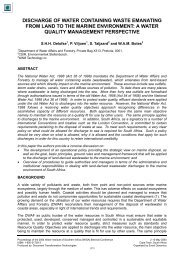Eskom and Water - eWISA
Eskom and Water - eWISA
Eskom and Water - eWISA
Create successful ePaper yourself
Turn your PDF publications into a flip-book with our unique Google optimized e-Paper software.
ESKOM AND WATER<br />
Vasanie Pather<br />
<strong>Eskom</strong>: Primary Energy (<strong>Water</strong>), PO Box 1091, Johannesburg, 2000.<br />
ABSTRACT<br />
<strong>Eskom</strong>, the South African wholly state-owned electricity utility, is among the top ten utilities in the<br />
world in terms of size <strong>and</strong> sales. With its 24 power stations <strong>and</strong> nominal capacity of 40 585<br />
megawatts, it is also one of the lowest cost producers of electricity in the world. <strong>Eskom</strong>’s power<br />
stations supply in excess of 95% of South Africa’s electrical energy, <strong>and</strong> more than half of the<br />
electricity used on the African continent.<br />
The main component of operational costs for a coal-fired power station is fuel, i.e. coal. The power<br />
stations are constructed close to the coalfields to eliminate the high cost of coal transportation.<br />
These coal fields are located in the dry regions of the country where water availability is low hence<br />
it is necessary to transfer water from neighboring regions, to the locality of the power station. The<br />
generation of electricity is entirely dem<strong>and</strong> driven since storage is very limited. Since water is a<br />
vital input to the process, a high level of assurance is required by <strong>Eskom</strong>, emphasising the priority<br />
that water is given as a resource.<br />
Over the years <strong>Eskom</strong> has initiated various new technologies <strong>and</strong> management protocols in order<br />
to control <strong>and</strong> reduces its water use. These include construction of dry cooled power stations,<br />
desalination of mine water for re-use, minimising effluent discharge, introduction of water as an<br />
indicator in the performance management system etc.<br />
As a direct result of <strong>Eskom</strong>’s use of innovative technologies, management practices <strong>and</strong> other<br />
strategies regarding water use since the late 1980’s, a significant reduction in water use has been<br />
achieved at its thermal power plants. The quantity of energy produced over the period 1989 to<br />
2003 increased by 62% (119 tigawatt hours per annum to 193 tigawatt hours per annum) but the<br />
corresponding increase in water consumption was only 22% (224 million cubic meters per annum<br />
to 273 million cubic meters per annum). This improved water use efficiency equates to a saving of<br />
1020 million cubic meters since 1989, which equates to nearly 4 times <strong>Eskom</strong>’s average water use<br />
per annum<br />
INTRODUCTION<br />
<strong>Eskom</strong>, the South African wholly state-owned electricity utility, is among the top ten utilities in the<br />
world in terms of size <strong>and</strong> sales. With its 24 power stations <strong>and</strong> nominal capacity of 40 585<br />
megawatts, it is also one of the lowest cost producers of electricity in the world. <strong>Eskom</strong>’s power<br />
stations supply in excess of 95% of South Africa’s electrical energy, <strong>and</strong> more than half of the<br />
electricity used on the African continent.<br />
In pursuing its function of supplying the electricity on which modern society depends, <strong>Eskom</strong><br />
operates a wide portfolio of generation technologies which includes coal-fired power stations, gas<br />
turbine, hydroelectric – both conventional <strong>and</strong> pumped storage, nuclear <strong>and</strong> wind turbine.<br />
<strong>Eskom</strong> uses three major sources of energy for electricity generation, i.e. coal, nuclear <strong>and</strong> water.<br />
Coal-fired power stations account for the largest proportion of the production (89% of its operating<br />
generation capacity) making <strong>Eskom</strong> one of the single biggest consumers of water in South Africa,<br />
accounting for approximately 1.5% of the country’s total water consumption. Approximately 97% of<br />
<strong>Eskom</strong>’s total power generation water usage is for cooling purposes at the coal-fired stations.<br />
Therefore it is in this area that <strong>Eskom</strong> has concentrated their effort in water conservation, <strong>and</strong> as<br />
Proceedings of the 2004 <strong>Water</strong> Institute of Southern Africa (WISA) Biennial Conference 2 –6 May 2004<br />
ISBN: 1-920-01728-3 Cape Town, South Africa<br />
Produced by: Document Transformation Technologies Organised by Event Dynamics
such this is the focus of this paper.<br />
The company has taken a pro-active stance in its efforts to conserve water, in some cases even<br />
pre-empting new legislation in implementing efficient <strong>and</strong> effective water use practices. It has<br />
constantly striven to improve on its water use targets, continually researching <strong>and</strong> implementing<br />
new technologies to reduce or limit water use, <strong>and</strong> working closely with the Department of <strong>Water</strong><br />
Affairs <strong>and</strong> Forestry (DWAF) to contribute towards long-term water resource planning <strong>and</strong><br />
management. This commitment is documented in <strong>Eskom</strong>’s <strong>Water</strong> Management Policy.<br />
INNOVATIVE USE OF WATER TECHNOLOGIES<br />
Over the last two decades, <strong>Eskom</strong> has introduced a number of innovative technologies to save<br />
water. These include dry cooling - both direct <strong>and</strong> indirect, desalination of polluted mine water for<br />
use at power stations, use of limited pumped storage <strong>and</strong> hydropower potential <strong>and</strong> technical<br />
improvements in treatment regimes to maximise the beneficial use of water.<br />
Dry Cooling<br />
In the 1960’s <strong>and</strong>1970’s, <strong>Eskom</strong> realised the limitations in South Africa’s water resources <strong>and</strong><br />
investigated <strong>and</strong> tested the use of dry cooling technology for its new coal-fired power stations.<br />
Today, the total dry cooled installed capacity is 10 477 megawatts.<br />
Dry-cooling technology does not rely on evaporative cooling for the functioning of the main cooling<br />
systems. As a result dry cooled power stations use approximately 15 times less water than<br />
conventional wet cooled power stations. <strong>Eskom</strong>’s leading role in this field is attested to by the fact<br />
that it operates the largest indirect dry cooled power station (Kendal – 4 116 megawatts) <strong>and</strong> the<br />
largest direct dry cooled power station (Matimba – 3 990 megawatts) in the world (figures 1 <strong>and</strong> 2).<br />
Figure 1. Kendal Power Station. Figure 2. Finned tube condensers above forced<br />
draught fans at Matimba Power Station.<br />
The investment in dry-cooling results in an estimated combined saving of over 200 Ml/day<br />
megaliters of water per day, or in excess of 90 million cubic metres per annum (figure 3).<br />
Despite the limitations of dry cooling technology, such as a loss of operational efficiency with a<br />
concomitant loss in revenue, <strong>and</strong> higher capital <strong>and</strong> operating costs, this investment is imperative<br />
on a national perspective.
Figure 3. <strong>Water</strong> savings due to Dry Cooled Technology from 2000 to 2003 (based on average wet cooled<br />
coal fired power station water use).<br />
Desalination<br />
The National <strong>Water</strong> Act (Act No. 36 of 1998) prohibits the discharge of wastewater into water<br />
resources without proper authorisation. Wastewater has to be treated to acceptable st<strong>and</strong>ards<br />
before it may be discharged. The mines that supply coal to <strong>Eskom</strong>’s power stations produce<br />
significant volumes of wastewater. <strong>Eskom</strong> accepts this water from the mines associated with two<br />
power stations. They treat the water then use it in their cooling process.<br />
Figure 4. Process Flow Diagram showing reverse osmosis <strong>and</strong> microfiltraion units in Lethabo Power<br />
Station’s water treatment plant.<br />
The two power stations, namely Tutuka <strong>and</strong> Lethabo (figure 4), operate desalination plants to treat<br />
the contaminated mine water. These plants were initially commissioned in 1985 <strong>and</strong> both were<br />
later refurbished. Desalination processes are relatively expensive. The total capital cost for both<br />
the treatment plants was about US$ 7 million. The operational cost is also very high, which
negatively impacts the financial feasibility of installing this technology. Both desalination plants use<br />
spiral wound reverse osmosis membranes in their process, <strong>and</strong> delivers permeate water recovery<br />
rates of 87% <strong>and</strong> 80% respectively. The benefit to <strong>Eskom</strong> is a reduced water intake for the two<br />
stations, with a combined potential saving of about 14.6 Ml/day (5.16 million cubic meters per<br />
annum).<br />
Lime Treatment<br />
When water supply is unlimited, operating a thermal power station with a once-through cooling<br />
process is ideal. For <strong>Eskom</strong>, however, the location of power stations is dependent on coal sources,<br />
usually where the water supply happens to be scarce, hence water is recycled in the cooling<br />
process. The cooling water systems have to be supplemented as a result of evaporation, windage<br />
<strong>and</strong> drift. Evaporation causes a concentration of salts in the cooling water recycle process, which in<br />
turn limits the recycle volumes. To overcome this, <strong>Eskom</strong> practices alkalinity control of the cooling<br />
water, using acid neutralisation (at two plants) or cold lime softening by precipitation (at six plants).<br />
This is largely dependent on the chemical drivers of the ash dump as compared to the abstracted<br />
raw water. By controlling <strong>and</strong> optimising these processes cooling water effluent volumes are<br />
minimised.<br />
<strong>Eskom</strong> is probably the world leader in operating large cooling water systems at high cycles of<br />
concentration without the use of corrosion <strong>and</strong> scaling inhibitors. Operation at elevated cycles of<br />
concentration is one of the key strategies contributing to water conservation.<br />
Hydropower <strong>and</strong> Pumped Storage<br />
<strong>Eskom</strong> operates hydropower stations with a total capacity of 661 megawatts, <strong>and</strong> pumped storage<br />
stations with total a capacity of 1400 megawatts. These stations are mainly operated during<br />
periods of peak electricity dem<strong>and</strong>.<br />
South Africa has limited potential for large-scale hydroelectric power due to limited water<br />
resources. River flows in South Africa are not constant, but vary from high floods to low flows. In<br />
order to provide energy at a very high assurance level, run of river schemes are generally not a<br />
feasible option. Hence large <strong>and</strong> expensive storage dams have been constructed to facilitate<br />
hydropower production. Apart from a small quantity of water lost to evaporation, pumped storage<br />
schemes do not consume water.<br />
Figure 5. Gariep Hydro Power Station on the Orange River.<br />
The utilisation of hydro power <strong>and</strong> pump storage stations results in a water saving of about 2.7<br />
million cubic meters per annum.<br />
INNOVATIVE WATER AND WASTEWATER MANAGEMENT PRACTICES<br />
Limiting water consumption <strong>and</strong> eliminating the contamination of water resources are <strong>Eskom</strong>’s<br />
main goals with water management. This has been successfully achieved in a number of ways.
Re-Use of <strong>Water</strong> Through Cascading<br />
<strong>Eskom</strong> adopted the ZLED (Zero Liquid Effluent Discharge) policy during 1987, in terms of which all<br />
reasonable measures are taken to prevent pollution of water resources through the establishment<br />
of a hierarchy of water uses based on quality. Cascading the water from higher quality to lower<br />
quality uses enables extensive re-use. Where possible, water is lost only through evaporation,<br />
retaining the accompanying dissolved <strong>and</strong> suspended solids. The net result is that there is no<br />
deliberate discharge of pollutants to a water resource under normal operating conditions <strong>and</strong><br />
average climatic conditions.<br />
Ash Disposal<br />
The coal-fired power generation process produces large quantities of ash, which is disposed of in<br />
ash dumps <strong>and</strong> dams. <strong>Eskom</strong> uses coal of a low grade (16 megajoules per kilogram to 22<br />
megajoules per kilogram) which produces a larger mass of ash during combustion. The<br />
higher-grade predominantly serves the export market. <strong>Eskom</strong> uses either wet or dry ashing. Both<br />
utilise effluent water or wastewater, which is the end product of the cascading water re-use<br />
process. Wet ash disposal entails the hydraulic conveyance of ash, while dry ash disposal entails<br />
the conveyance of partially moistened ash on conveyer belts. The dry ash disposal method<br />
requires less water.<br />
The volume of wastewater that can be accommodated in the ash is referred to as the effluent sink.<br />
Good water management <strong>and</strong> accurate water balances ensure optimisation of the effluent sink.<br />
The water saving is realised in that clean water is not used to suppress the blow off from the dry<br />
ash. Contamination of water resources is furthermore minimised as the output of the cascading<br />
water re-use process is not discharged into a water resource but assimilated into the ash.<br />
INNOVATIVE WATER MANAGEMENT STRATEGY<br />
A direct relationship, expressed as liters per kilowatt-hour (l/kWh), exists between energy produced<br />
<strong>and</strong> water consumed, <strong>and</strong> is calculated by dividing water consumption by energy sent out. This<br />
relationship is commonly referred to as 'specific water consumption' <strong>and</strong> is the key indicator for the<br />
organisation’s water management drive. This measure is used to assess the performance of both<br />
individual power stations <strong>and</strong> the company as a whole.<br />
Sustainability Index (SI)<br />
The SI was introduced in 1996 to ensure the long-term sustainability of <strong>Eskom</strong>’s business in the<br />
areas of technical, financial, social <strong>and</strong> environmental issues. The SI forms part of the performance<br />
contract of each employee from executive level to the operational level, With the targets for the<br />
various elements allocated according to the responsibility <strong>and</strong> accountability exercised within that<br />
area. The specific water use indicator (l/kWh) forms part of the SI. Using this index <strong>Eskom</strong> is able<br />
to monitor its water use, allowing water practitioners to identify individual power stations with<br />
specific water management problems in order to implement targeted corrective strategies. The<br />
historical data shows a decrease in the specific water consumption (for all <strong>Eskom</strong> generation<br />
technologies) from 2.85 l/kWh in 1980 to 1.29 l/kWh in 2003.<br />
COMMITMENT TO CO-OPERATIVE GOVERNANCE<br />
<strong>Eskom</strong> has fostered an excellent relationship with DWAF over the last four decades. As a major<br />
stakeholder in the water industry, <strong>Eskom</strong> assists <strong>and</strong> supports DWAF in its infrastructure planning,<br />
water management initiatives <strong>and</strong> formulation of policies. The company has been a corporate<br />
sponsor of the South Africa’s National <strong>Water</strong> Week Campaign for over 5 years <strong>and</strong> takes an active<br />
role in promoting this event on a regional level as well as <strong>Eskom</strong>’s power stations. The<br />
organization has recently been selected as patron member of the <strong>Water</strong> Institute of South Africa<br />
(WISA) in 2003.
CONCLUSION<br />
As a direct result of <strong>Eskom</strong>’s use of innovative technologies, management practices <strong>and</strong> other<br />
strategies regarding water use since the late 1980’s, a significant reduction in water use has been<br />
achieved at its thermal power plants. The quantity of energy produced (for coal fired power stations<br />
only) over the period 1989 to 2003 increased by 62% (119 tigawatt hours per annum to 193<br />
tigawatt hours per annum) but the corresponding increase in water consumption was only 22%<br />
(224 million cubic meters per annum to 273 million cubic meters per annum). This improved water<br />
use efficiency equates to a saving of 1020 million cubic meters since 1989, which equates to<br />
nearly 4 times <strong>Eskom</strong>’s average water use per annum. This is an achievement of which the<br />
organisation is rightfully proud, <strong>and</strong> it will continue to strive to improve in its performance to assist<br />
in conserving <strong>and</strong> preserving the nation’s scarce <strong>and</strong> precious water resource.<br />
REFERENCES<br />
Figure 6. Liters per kilowatt energy sent out for coal fired power stations.<br />
1. Technical Information, Matimba - Power for Tomorrow, Communications Department - <strong>Eskom</strong>,<br />
(1995).<br />
2. Technical Information, Kendal – breaking through new technology, Communications Department,<br />
<strong>Eskom</strong>, (1985).<br />
3. <strong>Water</strong> Book for Chemists, Training Manual, D. J Hanekom, (2000).<br />
4. Chemistry St<strong>and</strong>ard for Cooling <strong>Water</strong>, D. J Hanekom, GGS 1153, (2003).<br />
5. <strong>Eskom</strong> Annual Report, (2002).<br />
6. Personal Communication, D Hanekom, Chief Consultant, <strong>Eskom</strong> – Primary Energy (<strong>Water</strong>).



